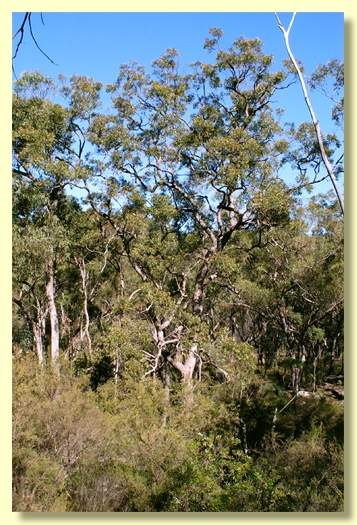Angophora
Euclid - Online edition
Angophora woodsiana
Angophora intermedia DC. var. woodsiana (F.M.Bailey) F.M.Bailey, Queensland Fl. 2: 605 (1900); A. lanceolata var. woodsiana (F.M.Bailey) Maiden, Forest Fl. New South Wales 2: 16 (1804); A. floribunda var. woodsiana (F.M.Bailey) Domin, Biblioth. Bot. 89: 459 (1928); Eucalyptus woodsiana (F.M.Bailey) Brooker, Austral. Sys. Bot. 13: 137 (2000). T: Queensland: Eight Mile Plain, F.M.Bailey s.n., holo: BRI.
Medium-sized tree to 20 m high. Forming a lignotuber.
Bark rough, fibrous to flaky, grey or brown. Glands (or ducts) sometimes present in the pith but only seen just below the nodes on young branchlets.
Juvenile growth (coppice or field seedlings to 50 cm): stem rounded in cross-section; juvenile leaves opposite, petiolate or sessile, ovate to lanceolate, 5.5–10 cm long, 2–3 cm wide, base amplexicaul to rounded to tapering to petiole, margin entire, apex pointed, green, leaf hairs absent.
Adult leaves opposite, petioles 1–2 cm long; blade lanceolate or falcate, 7.5–17 cm long, 1.7–4.5 cm wide, flat, base tapering to petiole, margin entire, apex pointed, discolorous, glossy, green, penniveined, densely to very densely reticulate, intramarginal vein present, oil glands small, island or obscure.
Inflorescence terminal compound, peduncles 0.9–3.2 cm long, buds 3 or 7 per umbel, pedicellate, (pedicels 1–1.8 cm long). Mature buds globular (0.6–0.7 cm long, 0.6–0.7 cm wide), hypanthium smooth or hairy, longitudinally ribbed, petals white with a green keel, stamens inflexed, anthers oblong, versatile, dehiscing by longitudinal slits (non-confluent), style long, stigma blunt, mop-like, locules 3 or 4, the placentae each with 5 vertical ovule rows. Flowers white or creamy white.
Fruit pedicellate (pedicels 1–2 cm long), cup-shaped, 1.2–1.5 cm long, 0.9–1.6 cm wide, longitudinally ribbed, disc descending, valves 3 or 4, enclosed.
Seeds reddish brown to brown, flattened-ellipsoidal, dorsal surface smooth, hilum ventral.
Cultivated seedlings (measured at ca node 10): not grown yet.
Flowering has been recorded in January and December.
A. woodsiana is a small to medium-sized tree, or in coastal areas may be a mallee. Found in coastal northern New South Wales and south-eastern Queensland, its distribution ranging from Evans Head to as far north as Fraser Island, with sporadic occurrences on the Darling Downs west of the Great Dividing Range near Brisbane. A. woodsiana differs from the other members of the group by the broader adult leaves, longer petioles and pedicels, usually longer than 1 cm (pedicels usually less than 1 cm in all the others).
MORE ABOUT ANGOPHORA











